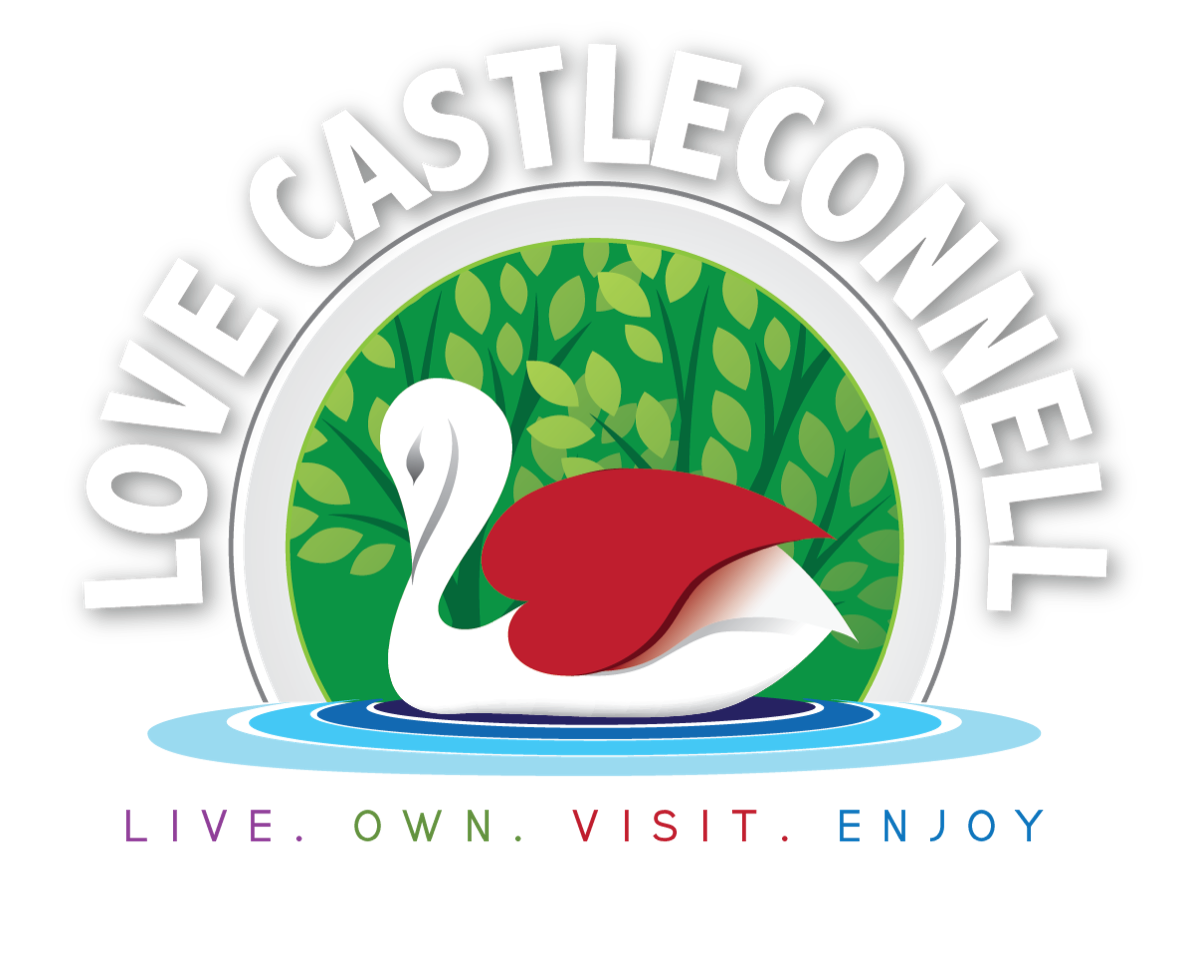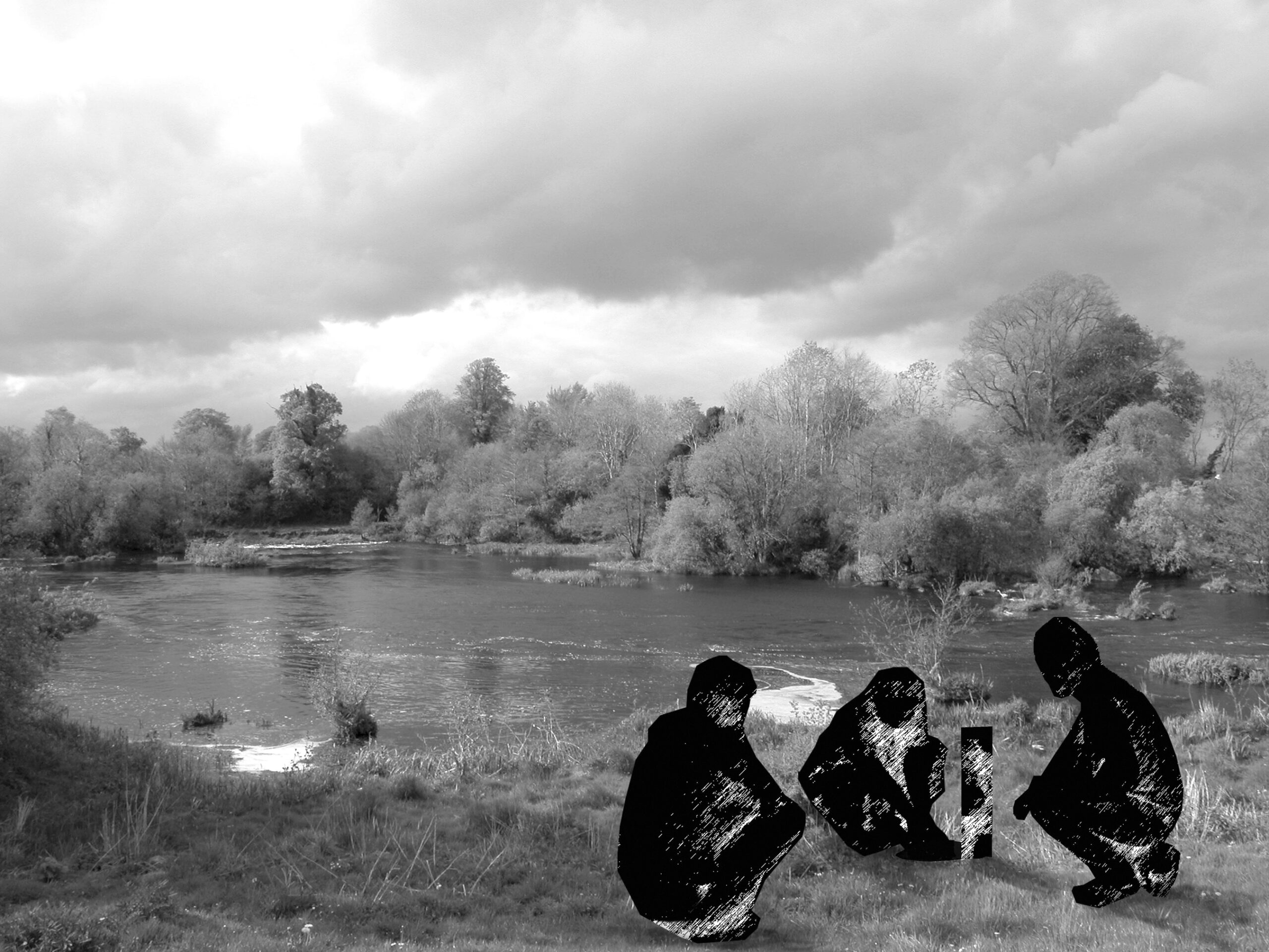A Summary of Archaeological Excavations at Hermitage, Castleconnell, Co. Limerick
Tracy Collins, PhD MIAI, Aegis Archaeology Limited. tracy@aegisarc.com
Introduction
Archaeological excavations in the townland of Hermitage, near Castleconnell, Co. Limerick, were undertaken over four weeks in 2001 by Aegis Archaeology for the then Limerick County Council, in advance of a pipe-laying scheme, beside the River Shannon, as it traversed a recorded archaeological monument (RMP LI001-001), a fishing place on the River Shannon. The area of excavation was approximately 450 metres long by 11 metres wide, running beside the River Shannon along its left bank. The excavations revealed that this area had been used in places over a long period of time. Prehistoric features, for example a fulacht fiadh, dating to the Bronze Age, were uncovered. It was a surprise to discover features of Mesolithic date, as they are relatively rare. Most notably, two cremation burials dating to the Early Mesolithic period were excavated. Following analysis, some of which is still ongoing, it can be concluded that these cremation burials are currently the oldest in Ireland, and amongst the oldest in Europe. They are also important as one of the cremation burials contained a large adze axe, which because of this association can now be dated, and it is one of the oldest adze axes in Europe. The excavation at Hermitage gives a rare glimpse of how hunter gatherers used natural materials from their locality, such as stone, wood and the river itself in the Mesolithic period. Currently, the Mesolithic period in Ireland has the earliest evidence for the occupation of the island by groups of hunter-gatherers. It is thought that these people arrived in Ireland by about 8,000 BC, and it is most likely that they crossed the sea in small boats. They followed a gathering and hunting lifestyle using stone tools that they manufactured, likely moving around in an area seasonally, following their food sources. These hunter-gatherers lived successfully in Ireland until about 4,000 BC, when the first agricultural practices, plants and animals arrived in Ireland. The following is a summary of the Mesolithic features found at Hermitage.
Cremation Pit A
This was a sub-circular pit and a post-hole was cut into its base, measuring about 0.60 metres in depth and 1 metre in width. The pipe of a post-hole could be seen during excavation due to its different-coloured fill, which suggested that there was originally a marker projecting from the pit itself. At the base of the pit, around where the post would have been and arranged in a crescent, was the cremation itself. At the centre of the pit, resting against where the post would have been, was a large polished stone axe (of adze type), positioned blade down, which showed evidence of burning. The fill of the pit contained one stone microlith and a possible second was retrieved. Microliths are typical tools of the Irish early Mesolithic period. Charcoal gathered from the fill of the pit showed that alder and a crab-apple-type wood had been burned as fuel for the pyre. This wood could have grown locally along the river bank.
IMAGE: Pit A rod showing post position
Cremation Pit B & Pit C
Pit B was a larger cremation pit than Pit A, measuring 2.3 metres north-south by 1.5 metres and was 0.65 metres in depth. The single fill contained the cremation, with heat-shattered stone and small fragments of baked and burnt clay, though the pit edges did not exhibit evidence of burning. Pit C which was sub-circular, measuring about 0.7 metres and 0.5m in depth, contained minute fragments of cremated bone, too small for positive identification. Charcoal samples from these pits, which were also of crab-apple-type wood both produced Mesolithic dates.
The Cremated Human Remains
Although Pit C contained cremated remains, they were too small to identify to species or to radio carbon date. Pit A contained the cremated remains of a single adult (probably male) individual. The remains weighed almost two kilograms at 1,979g. Due to the volume of cremated bone material it is suggested that this represents the cremation of an entire individual. This had been a well-executed cremation, which demonstrated that the hunter gatherers who carried out the task were skilled in the processes. Cremation of a body is a difficult task requiring temperatures of well over 1000 degrees Celsius. This high temperature must be retained for several hours within the pyre in order for the body to be cremated properly. A single adult (sex unknown) was recovered from Pit B. The cremation weighed just 179g. It is suggested from this small amount that this may represent a ‘token burial’, in contrast to pit A. In this instance the entire body may have been cremated with a small portion of the bones being deposited in the pit, or it may be that only a portion of the body itself was chosen for cremation. During the excavation very little evidence of the pyre sites was discovered, though an area to the east of Pit A was fire-reddened, and this could have been the location of the pyre.
Early Occupation Activity
This was a discrete area of intense activity, (in area B near Pit B), with many stakeholes and slot trenches that may have once formed huts. A stone axe (also of adze type) was recovered from a sealed context within this area. Charcoal found here was of oak, which could have grown near the site, also returned a Mesolithic date.
Stone Tools and Adze Axe
Of the 200 or so stone tools found along the entire 450 metre stretch investigated, a small selection dated to the Mesolithic period. These were made of different types of stone including flint, chert, shale and mudstone, all of which could be found in the locality of Hermitage, flint being the rarest in the locality, but the best material with which to make stone tools. Perhaps the most important artefact recovered was the polished adze (axe) found in Pit A with the cremation. This axe is technically an adze due to its distinctive shape and the way it would have been hafted. Dr Aimee Little and her colleagues at York University have microscopically analysed this adze and found that it was very well made, was used to cut wood, after which it was deliberately blunted. A reasonable archaeological interpretation is that the adze was made for the person who was cremated and buried. It may have cut the wooden post which became the grave marker for the cremation, after which it was deliberately blunted and deposited with the burial. This adze axe is internationally important as it is currently the earliest known polished adze axe from a secure dated context in Europe.
IMAGE: Adze axe
Mesolithic Radio-carbon Dates
Charcoal samples from the burial pits and the cremated human bone were radio-carbon dated. Pit A returned the earliest dates. Pit A (charcoal) 7,550- 7,290 BC (‘before Christ’); Pit A (cremation tibial shaft) 7,530-7,320 BC. Pit B (charcoal) 7,030-6,630 BC; Pit B (cremation skull vault) 7,090-7,030 BC. Pit C (charcoal) 6,610-6,370 BC. Area B Occupation (charcoal) 4,680-4,040 BC.
Conclusions
Prior to the excavations at Hermitage there was no above ground indication of the features. The excavation was ‘development led’ in that it was undertaken to facilitate a rising water main. However, when compared to other known Mesolithic sites, the site at Hermitage is actually located in a classic early Mesolithic location; a ridge of high ground overlooking a river at a strategic fishing point. Perhaps this location was both practical and symbolic to the Mesolithic peoples that used it. Mesolithic hunter-gatherers who used Hermitage interacted with their environment by using local wood and stone. Although the excavation did not yield evidence to show that the river was used, it is highly likely it was used by them for transport, food, fishing, and water. Most unexpectedly, two well-preserved cremations were found, dating to the Early Mesolithic period (pit A being earlier than pit B). The Pit A cremation, in particular, illustrates a level of knowledge, sophistication and ritual, not previously recognised in the Irish Mesolithic, when in fact any burials are still extremely rare. The polished stone adze axe, suggests that the buried person was important and of high status while the posthole perhaps represents a grave marker, so that the burial might be remembered and returned to. The Mesolithic finds at Hermitage are internationally significant being amongst the earliest cremated burials in Europe. Work is continuing on the Hermitage assemblage and the cremations, and it is hoped that perhaps some further archaeological work may be undertaken at the site in the future.
Acknowledgements
Original excavation funding: Limerick County Council (now Limerick City and County Council). Analyses: stone axes, Prof. G. Cooney and the Stone Axe Project School of Archaeology UCD. Lithics, Prof. P.C. Woodman UCC. Human remains Dr L. Lynch. Charcoal, Dr E. O’Carroll. HARP (Hermitage archaeological research project) is a group of archaeologists led by Dr Aimee Little of York University who are investigating aspects of the Hermitage material (Dr Ben Elliott York University, Prof. Gabriel Cooney and Dr Graeme Warren University College Dublin, Prof. Rick Schulting University of Oxford, Dr Christophe Snoeck Vrije Universiteit Brussel; Dr Tracy Collins and Frank Coyne Aegis Archaeology Limited). As scientific techniques improve it is hoped that more can be learned from this important assemblage – so watch this space!
Some Further Reading
Collins, T. 2009 Hermitage, Ireland: life and death on the western edge of Europe in Mesolithic Horizons. Oxford: Oxbow, 876-879.
Collins, T. and Coyne, F. 2003 Fire and Water… early Mesolithic cremations at Castleconnell, Co. Limerick, Archaeology Ireland, 17(2), 24-27.
Little, A. van Gijn, A., Collins, T., Cooney, G., Elliott, B., Gilhooly, B., Charlton, S. and Warren, G. 2016 Stone Dead: uncovering early Mesolithic mortuary rites, Hermitage, Ireland, Cambridge Archaeological Journal, 1-21.
Micklejohn, C. and Woodman, P. 2012 Radio carbon dating of Mesolithic human remains in Ireland, Mesolithic Miscellany, 22(1), 22-41. Available online at https://sites.google.com/site/mesolithicmiscellany/
Woodman, P. 2015 Ireland’s First Settlers Time and the Mesolithic. Oxford: Oxbow.

